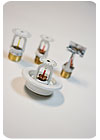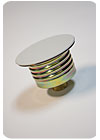
“You put your trust in these places.” Those were the words of Evelyn Castro, after learning that her 72-year-old mother had died in a nursing home fire in Hartford, Conn. The first alarm was reported just before 3 a.m., on Wednesday, Feb. 26, 2003, and the fire left 10 dead and 23 injured. One day short of seven months later, a similar blaze in Nashville claimed eight lives and injured 20. How can facilities that house the elderly be deemed “safe” without fire sprinklers?
The national fire statistics for nursing home facilities are surprising. The sites average 2,300 fires nationally per year. Thanks to fire sprinkler systems, most are controlled or extinguished by the operation of one or two sprinklers and seldom make the news. But in the 18 worst fires since 1970, all shared the common theme of lack of sprinklers in the patient rooms and adjoining corridors. The death toll from those 18 fires is more than 200 people.
Fire Protection Laws For New Vs. Existing Construction
Federal laws require all newly constructed facilities to be equipped with smoke detectors and working fire sprinkler systems. Smoke detectors are a great means of alarming the facility and beginning the evacuation process, but sprinklers are critical to quickly respond to the fire and control its spread. Despite these requirements for new construction, many existing homes have been “grandfathered” and continue to operate without automatic fire sprinkler protection.Federal legislation continues to be introduced that ranges from economic incentives to install sprinklers to mandated retrofitting of sprinklers for all nursing home facilities.
When considering a care facility for their family members, most people are concerned with the housekeeping, maintenance, cleanliness, and the amount of care and staffing that is provided. But how many take the time to look to the ceiling for the presence of fire sprinklers? For most of us in this business, it is almost an involuntary reaction when entering any building. We would not stay in an unsprinklered hotel or work in an unsprinklered building. Moving our loved ones into an unprotected nursing home would be inexcusable.

New Fire Protection Technology
For the building owners, designing engineers and installing sprinkler contractors, products have evolved since the first of the 18 fires referenced previously. Today’s sprinklers and materials have become even more efficient, effective and cost-saving. The NFPA design criteria for such occupancies have also changed. The common areas are still considered light and ordinary hazard, depending on the fire loads, but if the building does not exceed four stories, much of the remainder of the building now falls under NFPA 13R for residential occupancies.“Veterans” in this industry can relate to surveying existing nursing homes for the retrofit installation of sprinklers. The sprinklers at that time were standard response, and the maximum coverage for a light hazard occupancy was 15 feet x 15 feet for an upright or pendent sprinkler, and sidewalls were extremely limited - most to a maximum throw of 14 or 15 feet. Sprinklers in ordinary hazard areas were limited to 130 square feet per sprinkler, with a maximum of 15 feet in any one direction between sprinklers.
Today’s products for residential, light and ordinary hazard installations are limited to a maximum of 400 square feet per sprinkler, and sidewall sprinklers often throw 22 to 24 feet. The large open area of most patient care rooms can be protected by a single sprinkler. Smaller orifice sprinklers requiring less flow are often used for areas such as entries, bathrooms and closets. If less than the NFPA minimums, sprinklers in small closets and bathrooms can be omitted.
The new technology that has been designed for residential installations (applicable to patient care areas) is also far different than the standard sprinklers that are installed in commercial and industrial applications. Traditional commercial sprinklers have an “umbrella” pattern that opens fully well below the sprinkler deflector. For residential occupancies, including nursing homes, wall hangings and decorations are common. As a result, the tests for residential sprinklers require wall wetting no more than 22 inches from the ceiling at the maximum sprinkler spacing.
This means that sprinklers are designed, at their minimum operating pressure of 7 psi, to wet the wall at that corresponding maximum spacing from the wall. Today’s residential sprinklers are expected to be effective and to control a fire, regardless of the fact that the curtains extend to the ceiling or that added wall hangings are present.
The demands don’t stop with the discharge pattern. Old sprinkler solder-link technology would never have allowed the sprinklers to open in time to keep the fire from spreading at the extended spacing. Not only do the sprinklers have to throw water in excess of 20 feet, the thermal elements have to respond to a fire in a corner of the room farthest from the sprinkler location.
This has been made possible by today’s quick-response technology. All sprinklers have a thermal operating element that responds to heat. The operating element, whether solder-link or glass-bulb style, must be heated to its rated temperature to actuate in a fire condition (unless the element is physically damaged and removed). Accelerating the operation, or making the element more sensitive, becomes an exercise of removing the amount of mass in the element that must be heated. The demands for quick response elements have led to lighter and smaller solder elements and an evolution from 11-mm to 8-mm to 5-mm bulbs, all of which are considered “standard response” devices, to today’s common “quick response” 3-mm bulb.
In the case of concealed sprinklers, the task is even more difficult. The operating elements of the sprinklers are hidden behind flat or domed decorative plates. In order for the sprinkler to operate, the thermal element must be subjected to heat, but the element is shielded by the plate. Manufacturers have gone to great lengths to assure that the plates separate at a lower temperature and clear the sprinkler, and that the sprinkler assembly above the plate is subjected to airflow from the room being protected - even before the plate separates - in order to assure proper response times.
All of the commercial and residential sprinklers that are listed and/or approved must pass rigid testing requirements. Today’s listing and approval test requirements go far beyond water distribution tests. Besides distribution and actual fire testing, the sprinklers are subjected to a variety of strength, durability, response and corrosion tests. Whether intended for life-safety applications or for a warehouse environment, all of the stringent requirements must be met. Sprinklers are products that are installed, though hopefully never used, but may be called on at any time in a span of many years to function exactly as designed, and they respond to that challenge every day.

Percentage of each state’s nursing homes that are fully sprinklered, the share of state population 75 or older and the total number of nursing homes.
Attic Fire Protection Requirements
Attic spaces are common above wood-joisted nursing homes. Although not required for locations that fall under the guidelines of NFPA 13R, protection of a combustible attic space above the patient areas is often required by the local code and authority having jurisdiction. For structures more than four stories, the requirements of NFPA 13 govern, and any combustible attics must be protected.The protection requirements for attics have been changed in the NFPA 2002 and 2007 codes, and a full discussion would require another article. In general, attics can be protected by standard spray sprinklers (although these have been shown to be ineffective for sloped attics in many fire tests), or through the use of specific-application attic sprinklers. In cold climates, attics present a potential freeze problem, and the use of dry sprinkler systems brings on an added set of penalties and restrictions when using standard spray sprinklers.
NFPA 13 requires that attics be designed for a density of 0.10 gpm/square foot over the most remote 1,500 square feet of area when using standard spray sprinklers. Specific-application attic sprinklers generally offer the advantage of calculating a set number of sprinklers, often without penalty for a dry system, and the ability to use CPVC pipe when installed in accordance with the manufacturer’s guidelines. Standard spray sprinklers encounter a 30 percent area penalty for dry system application, and an additional 30 percent penalty for slopes in excess of 2/12.
The penalties result in the worst-case scenario of a designed remote area of 2,535 square feet for a dry system - over 1,000 additional square feet when compared to the requirements for a wet sprinkler system, and at 0.10 gpm/square foot, the result is an additional 100+ gallons per minute through the system. When a wet system is used, an additional 25 percent area credit can be taken for the use of quick response sprinklers, decreasing the area calculation requirement to 1,125 square feet. This credit is not applicable for dry systems, penalizing the dry system an added 38 gpm, resulting in an added total penalty of nearly 150 gpm for a dry system. The NFPA requirements for standard spray sprinkler application for attic protection should be closely followed, as well as the manufacturer’s guidelines for specific-application attic sprinklers.
The debate over the requirement for fire sprinklers is ongoing - from nursing homes to single-family homes. For nursing home applications, lighter and easier to install materials, fewer sprinklers required, quicker response to fires, and products that have been specifically designed to optimize cost and effectiveness combine to make fire protection even more effective and affordable.
All of this has been done in response to the age-old concerns about cost. With respect to nursing homes, city names that have made recent headlines like Hartford and Nashville help to silence the cost critics, and nothing resurrects the cry for protection like the loss of life in a fire. In the meantime, the federal and state governments continue to wrestle with the question of mandating retrofitting existing nursing homes with fire sprinklers.
Ultimately, the decision is really ours. If you have to put a loved one in a care facility, please look up at the ceiling before you decide.